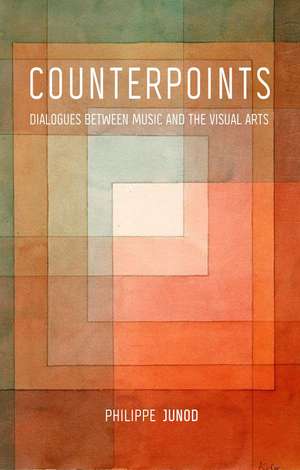Counterpoints: Dialogues between Music and the Visual Arts
Autor Philippe Junod Traducere de Saskia Brownen Limba Engleză Hardback – 14 feb 2018
Multimedia experiments are everywhere in contemporary art, but the collaboration and conflict associated with multimedia is not a new phenomenon. From opera to the symphonic poem to paintings inspired by music, many attempts have been made to pair sounds with pictures and to combine the arts of time and space. Counterpoints explores this artistic evolution from ancient times to the present day.
The book’s main focus is music and its relationship with painting, sculpture, and architecture. Philippe Junod draws on theoretical and practical examples to show how different art movements throughout history have embraced or rejected creative combinations. He explains how the Renaissance, neoclassicism, and certain brands of modernism tried to claim the purity of each mode of expression, while other movements such as romanticism, symbolism, and surrealism called for a fusion of the arts. Counterpoints is a unique cultural history, one that provides a critical understanding of a popular but previously unheralded art form.
The book’s main focus is music and its relationship with painting, sculpture, and architecture. Philippe Junod draws on theoretical and practical examples to show how different art movements throughout history have embraced or rejected creative combinations. He explains how the Renaissance, neoclassicism, and certain brands of modernism tried to claim the purity of each mode of expression, while other movements such as romanticism, symbolism, and surrealism called for a fusion of the arts. Counterpoints is a unique cultural history, one that provides a critical understanding of a popular but previously unheralded art form.
Preț: 196.58 lei
Preț vechi: 233.51 lei
-16% Nou
Puncte Express: 295
Preț estimativ în valută:
37.63€ • 38.72$ • 31.72£
37.63€ • 38.72$ • 31.72£
Carte indisponibilă temporar
Doresc să fiu notificat când acest titlu va fi disponibil:
Se trimite...
Preluare comenzi: 021 569.72.76
Specificații
ISBN-13: 9781780238111
ISBN-10: 1780238118
Pagini: 224
Ilustrații: 40 halftones
Dimensiuni: 140 x 216 x 28 mm
Greutate: 0.7 kg
Editura: REAKTION BOOKS
Colecția Reaktion Books
ISBN-10: 1780238118
Pagini: 224
Ilustrații: 40 halftones
Dimensiuni: 140 x 216 x 28 mm
Greutate: 0.7 kg
Editura: REAKTION BOOKS
Colecția Reaktion Books
Notă biografică
Philippe Junod was professor of history of art at the University of Lausanne from 1971 to 2003. He is the author of numerous works on art theory. Saskia Brown is a translator who lives in Paris.
Recenzii
"An astonishing number of books have been written to propose or define various practical and theoretical harmonies of music and art. This is not another one of those books. This work expertly synthesizes the key issues, debates, and voices in the connections (or, just as importantly, disconnects) between music and the visual arts that have been ongoing for hundreds of years. Counterpoints accomplishes this by drawing on a remarkable array of primary and secondary sources from Pythagoras. . . . Junod’s cyclopedic knowledge and scholarly acumen, clever, playful style, and passion for music combine to make this a rare scholarly work that deserves readership beyond academia. The illustrations, ranging from the fifteenth to the twentieth centuries, illuminate the discussion and will intrigue the reader. This book is a polymath’s Kircherian exploration. Highly recommended for libraries supporting art, music, and architecture."
"From opera to the symphonic poem, to paintings inspired by music, many attempts have been made to pair sounds with pictures and to combine the arts of time and space. Counterpoints explores this artistic evolution from ancient times to the present day. . . . The anteriority and originality of Junod's work as well as his immense erudition is a great chance for English-speaking colleagues to have access to his 'unique cultural history that provides a critical understanding of a popular but unheralded art form.'"
"‘This is a comprehensive, historical introduction to the relationship between music and art. Junod examines that idea of an original unity between the arts, their battle for supremacy, and the complex interweaving of parallels, analogies, and synaesthesia (could colors be used like notes in a scale?). . . . This is a valuable and eloquent reference work, taking us to the dissolution of categories we find today."
"For decades colleagues and I have been enlightened and delighted by the insights of Junod, art historian extraordinaire with an expert passion for music (gleaned in part from study with Nadia Boulanger). At last English-speaking readers can enjoy his sympathy and depth of understanding, always conveyed with refreshing turns of phrase that lose nothing in this excellent translation. Reading Junod, I always sense anew, and with enjoyment, the rich fabric of our artistic history."
